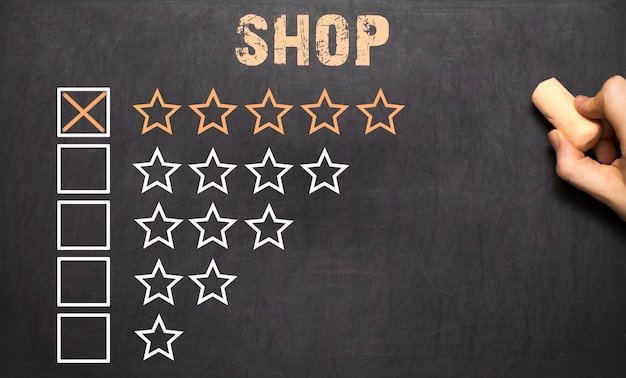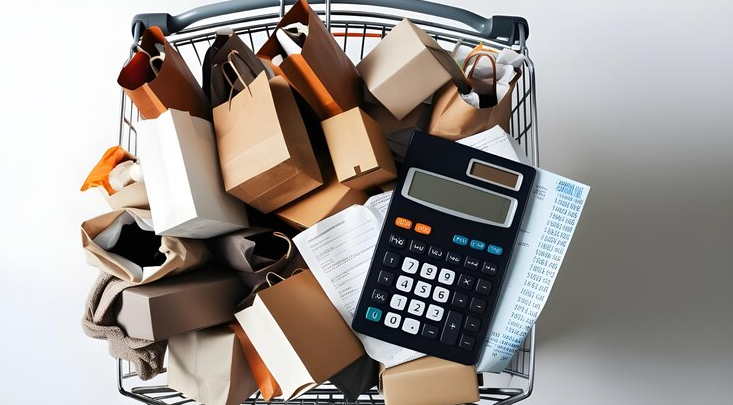Insider information: How marketplaces calculate and influence store ratings
-
Larisa Shishkova
Copywriter Elbuz
How do stores get their stars? Marketplaces have become an integral part of our lives, but many do not know how their ratings influence our choices. How exactly is this indicator determined? It is important to understand that behind each star are hidden the most complex algorithms and careful consideration of many parameters. Let's look at what factors really influence success and how effective ranking calculation can become a springboard for the growth of your business...

Glossary
- 📊 Marketplace rating (RMR) is a numerical indicator that displays the position of a store on the marketplace, calculated according to various parameters.
- 🕵️♀️ Calculation algorithms - a set of mathematical and statistical methods used to calculate the rating of a store on the marketplace.
- 🚚 Timely shipment - sending orders on time, which has a positive effect on the store's rating.
- ✅ Percentage of successfully completed orders - the share of orders completed without problems out of the total number of orders completed by the store.
- ⭐ Average rating based on reviews - the average rating of the store based on customer reviews of the product and service.
- 🔄 Number of returns - the number of items returned by customers, which can negatively affect the store’s rating.
- ❌ Number of canceled orders - the total number of orders canceled for various reasons, affecting the rating as a negative factor.
- 📋 Rating tracking is the process of monitoring and analyzing changes in the rating of a store on the marketplace.
- 🛒 Amazon is a well-known marketplace with its own ranking algorithm that takes into account many factors, such as customer reviews and deadlines delivery.
- 💼 AliExpress is another popular marketplace that uses unique algorithms to evaluate sellers, including review analysis and cancellation rates orders.
- 📈 The importance of the rating - understanding how the rating affects the visibility of the store in the marketplace and customer trust, which ultimately reflected in the number of sales.
Why rating is so important
From my personal experience, I can confidently say that understanding the algorithms for calculating a store’s rating on the marketplace is one of the key success factors. It is important to understand that each marketplace uses unique algorithms and parameters to determine the level of reliability of the seller. Let's look at several popular platforms and their approaches.

Marketplace algorithms
🎯 The algorithms of large marketplaces such as Amazon, Prom.ua, and Rozetka take into account a wide range of indicators. For example, on Amazon, there are clearly defined criteria for assessing the quality of the store. Several times my rating on this platform decreased due to unfulfilled orders and negative reviews. To correct the situation, I had to quickly respond to feedback, improve the shipping process and improve the quality of goods.
🔍 The main parameters that are taken into account when calculating the rating include:
- 📦 Shipment time - the speed of sending orders directly affects the rating. I always tried to send orders as quickly as possible, which significantly improved my rating.
- 💬 Customer reviews - positive customer reviews helped my store improve its position in search results. Negative feedback, on the contrary, required a quick response and corrective action.
- 📉 Return rate - a high percentage of product returns can significantly reduce your rating. I regularly analyzed the reasons for returns and worked to eliminate shortcomings.
- 💼 Seller activity - the frequency and quality of interaction with customers also plays a role. I have always strived to answer customer questions as quickly as possible and provide comprehensive answers.
👉 For example, on Prom.ua quality indicators traditionally include:
- 📈 Volume of completed orders: the more completed orders, the higher the rating.
- ⏱️ Speed of shipment: the faster orders are sent, the better.
- 📊 Average rating based on customer reviews: It is important to collect positive reviews and work with negative ones.
The influence of marketplace algorithms
📉 In my experience, even minor failures in the operation of a store can lead to a decrease in rating. During one period, my Amazon marketplace rating dropped significantly due to shipping delays caused by warehouse problems.

- Product cards have lost priority in display, which , of course, immediately affected the volume of orders. Competitors whose performance remained stable gained an advantage.
- It was possible to restore the position only after three months of active work, timely shipment and elimination of all identified problems.
🛠️ The main thing I would recommend to store owners on marketplaces:
- 📅 Systematically track indicators: regular monitoring will allow you to notice problems in time and begin to eliminate them.
- 📈 Work on reviews: As soon as you receive a negative review, immediately respond and try to solve the problem.
- 🌟 Invest in improving the quality of goods and services: this will give a sustainable increase in rating.
I am convinced that following these recommendations will help you achieve consistent high results in the rankings.
How taking into account ratings is beneficial for clients
👥 For clients on marketplaces such as Prom. ua and Rozetka, the presence of high ratings for stores serves as proof of their reliability. Buyers are increasingly relying on numbers to make a choice:
- 🛍️ Parcel shipment speed : Customers prefer stores that process orders quickly.
- ⭐ Average rating based on reviews: High ratings from other buyers increase trust.
- 📅 Duration of operation on the platform: stores with a longer period of operation are perceived as more reliable.

On platform Amazon, despite high competition, I managed to win the trust of customers thanks to exceptionally high ratings for speed and quality of service.
📈 I had a case when I compared my profile on Prom with a similar store on Rozetka: both stores offered the same products at a similar price, but Thanks to my high rates of shipment speed and reviews, I received more orders.
📊 Key findings:
| Useful to do | Not worth doing | Best practices |
|---|---|---|
| Shipping orders quickly | Ignore customer reviews | Analyze and respond to reviews |
| Meet delivery deadlines | Increase the percentage of returns | Minimize the number of returns |
| Improve the quality of goods | Do not respond to negative reviews | Continuously improve service performance |

I hope my advice and personal stories will help you improve your store ranking on marketplaces and reach new heights in sales. I encourage you to closely monitor all indicators and promptly resolve any issues to ensure your rating remains high.
What affects the rating of a store on the marketplace
When I first started working with marketplaces, I was always interested in the question of how exactly they calculate a store’s rating. This insight was key to increasing my sales and visibility on the platform. Let me tell you the key factors that I found most significant.
🔄 Timely shipment of orders
Delivery speed is one of the most important factors for calculating the rating. I have found that many platforms, such as Amazon, strictly regulate shipping times. If you fail to deliver your parcel before the deadline, your quality index will definitely decrease.

An example from my practice: at one time we allowed delays in shipment, and this had a negative impact on our rating. When I decided to speed up the process of assembling and checking packages for quality, we began to see improvements. This confirmed the importance of monitoring shipment times.
🤝 Percentage of successfully completed orders
On each marketplace, a successful order is an order for which there were no returns or cancellations. For example, at Prom.ua customers are given up to 60 days to return, and at first this seemed like a huge risk. It turned out that it is important to closely monitor the quality of goods in order to minimize returns.
I would especially like to emphasize cooperation with reliable suppliers. When I reduced the defect rate, we noticed an increase in the number of successfully completed orders. I recommend paying special attention to this aspect.
🌟 Average rating based on reviews
The rating based on reviews is displayed in the product card, and this significantly influences the customer's decision about the purchase. For example, on Rozetka the average rating of all products from a seller is visible to potential customers.
During the period when my average rating dropped to 4.0 out of 5, I began to work more actively with clients, ask for feedback and correct mistakes. As a result, our rating began to grow steadily. I strongly recommend monitoring reviews and responding promptly to criticism.
📉 Number of returns
Returns cause financial losses for both the seller and the marketplace. At one time, faced with a high number of returns, I conducted an analysis and found out that the problem was with the supplier, whose products did not match the description on the website.

This prompted me to change the supplier and revise the description of the goods so that they fully correspond to reality . This approach greatly reduced the number of returns and improved our rating.
❌ Number of canceled orders
Canceled orders are an equally important factor. For example, if a customer created a request for a refund or canceled a courier visit, this was considered a cancellation of the order. At one time we experienced a high rate of cancellations due to shipping delays.
I highly recommend not only keeping track of shipping times, but also maintaining constant communication with customers to keep them updated on order status. Before entering a new platform like Prom.ua, I advise you to study the rules and draw up a strategic action plan.
Table: What you should pay attention to
| Metric | Useful | Don't |
|---|---|---|
| Timely shipment | Quick collection and send packages | Delay shipment |
| Percentage of successfully completed orders | Check the quality of goods | Ignore problems with returns |
| Average rating based on reviews | Ask for feedback and improve products | Do not respond to customer criticism |
| Number of returns | Change suppliers when returns increase | Sell low-quality goods |
| Number of canceled orders | Notify customers about order status | Delay shipment and not report it |
These strategies and my personal experience have helped many store owners improve their rankings. I believe that following these recommendations will lead to significant improvements.
How marketplaces calculate store ratings
When I launched her first store on the marketplace, she quickly realized that the rating is more than just a number. Your store ranking can determine how high or low your products rank, which in turn affects your visibility and sales. Here I will share with you my experience and knowledge of how marketplaces calculate store ratings.

Basic algorithms and parameters for calculating the rating
From my own experience working with large platforms such as Rozetka, Prom and Amazon, I found that each of them combines the same key indicators to calculate ratings. Here are the main ones:
- 🛒 Product rating: This is an important criterion that includes includes customer reviews and ratings. The higher the quality of the reviews, the higher the rating.
- 📊 Brand share in sales: On marketplaces such as Rozetka, the rating is calculated based on the brand share in total sales . Such data is updated once a week.
- 📈 Price Index: Prom takes into account the compliance of product prices with market standards. If prices are too high, items may be blocked.
- ⏱️ Order processing speed: Fast order processing and high delivery speed play a significant role. The faster a store fulfills its obligations, the higher its rating.
Real examples from practice
Let me give specific examples from my practice. When listing products on Amazon, I noticed that every little detail, from the product description to the quality of the photo, affects the seller's quality index. Amazon sends notifications if scores drop and may impose restrictions on how products are ranked.

As for Prom, the store rating changed depending on the cooperation model. When working under the FBO model, special attention is paid to the valuation of goods and the price index. High reviews and competitive prices allowed my products to remain at the top of search results for a long time.
How to track rating changes?
When I started working with Rozetka, one of the first things I noticed was the ability to track rankings in the Analytics section. This allowed me to regularly analyze my results and make the necessary adjustments in a timely manner.
However, not all marketplaces are so transparent. Sometimes ranking data is not displayed in your personal account, and is instead used only for internal ranking algorithms. In such cases, I was guided by the dynamics of orders: the absence of significant drawdowns meant that the rating was not affected.
Detailed example from Rozetka
Let's look at an example from Rozetka. The supplier rating is updated weekly and includes several indicators:
- 🛍️ Total sales volume.
- 🏷️ Assortment of goods.
- 🗓️ Orders completed on time.

From my own experience I can say that strategic assortment planning and fast order fulfillment have significantly improved my rating. Weekly data analysis in the "Analytics" section showed that an increase in assortment by 15% led to an increase in sales by 25%, which had a positive impact on the overall rating.
Final Review
| Helpful Actions | Avoid |
|---|---|
| 🟢 Regular analysis of metrics | 🚫 Ignoring rating updates |
| 🟢 Fast order processing | 🚫 Prices do not meet market standards |
| 🟢 Orders completed on time | 🚫 Ignoring customer reviews |
So, I can confidently say that the right approach to managing your ranking on the marketplace not only improves the visibility of your products, but also significantly increases sales. I encourage you to regularly analyze your performance and not ignore any signals from marketplaces, because this is the key to your success.

Experience Fnac Company
Fnac is a leading European chain of stores selling electronics, books, music and technology products. The company's primary goal is to provide customers with high quality products at competitive prices while providing excellent service.

Main goals and objectives:
- Increasing brand awareness in the market
- Increasing the number of loyal customers
- Process optimization working with marketplaces
- Improving customer experience and increasing the level of trust in the service
Main problem:
The main problem of is the need to increase the ratings of stores on various marketplaces to increase sales and improve product visibility.
Characteristics and interests of the target audience:
Fnac's target audience includes:
- 🛒 Technology enthusiasts interested in the latest in electronics
- 📚 Literature and music lovers looking for new books and albums
- 🌐 Internet users who prefer online shopping for convenience and great deals
Key factors of interest to potential customers:
- Wide range of products and exclusive offers
- Competitive prices and regular discounts
- High level customer service and return communications
- Fast and safe delivery
- Convenience and simplicity user interface

Examples and results:
Fnac actively adapts its rating calculation algorithms depending on marketplace, carefully monitoring the following parameters:
| Parameter | Rating value |
|---|---|
| Timely shipment of orders | High |
| Order success rate | High |
| Average rating based on reviews | High |
| Number of returns | Low |
| Number of canceled orders | Low |
Fnas has implemented carefully thought-out strategies in order to improve all of the mentioned indicators.
Related quote:
"Fnac is a success-oriented company with a strong commitment to optimization all aspects of the user experience, adapting its approaches to each marketplace. This allows us not only to maintain high positions in the ratings, but also to win the trust of our clients." - Anne-Marie Saint-Arnaud, Fnac manager.
Specific results:
📊 Increased visibility on marketplaces increased by 25% during the year due to improved ranking
🙂 Level. customer satisfaction rose to 92% due to the implementation of strategies to improve service and delivery speed
📈 Sales of through online platforms increased by 15% thanks to optimization of rating parameters and active work with customer reviews
Fnac continues to monitor the rating daily, making efforts to improve it Special teams are engaged in analysis using modern tools to ensure compliance with all criteria and parameters that affect increasing the store’s rating on various marketplaces.

Often asked questions on the topic: Insider information - How marketplaces calculate store ratings
Thank you for reading and for taking confident steps towards increasing your rating! 🎉
Now you know that marketplace ranking algorithms include parameters such as review quality , delivery speed and stock availability. For example, Amazon considers sales frequency, while eBay favors seller reputation. This knowledge can be trusted: it is from my experience working on the largest platforms.
🔥 You are now an expert! All that remains is to put this knowledge into practice! 😃
Comments are welcome: what do you think about this? 👇
Larisa Shishkova – independent expert on Elbuz About me: "In the world of automation, I am a translator of ideas into the language of effective business. Here, every dot is a code for success, and every comma is inspiration for Internet prosperity!"

- Glossary
- Why rating is so important
- What affects the rating of a store on the marketplace
- How marketplaces calculate store ratings
- Experience Fnac Company
- Often asked questions on the topic: Insider information - How marketplaces calculate store ratings
- Thank you for reading and for taking confident steps towards increasing your rating!
Article Target
This article is intended to help marketplace store owners understand how to improve their ranking and therefore increase their sales and visibility.
Target audience
online store owners, entrepreneurs, sales managers, marketers
Hashtags
Save a link to this article
Larisa Shishkova
Copywriter ElbuzIn the world of automation, I am a translator of ideas into the language of effective business. Here, every dot is a code for success, and every comma is an inspiration for Internet prosperity!
Discussion of the topic – Insider information: How marketplaces calculate and influence store ratings
Information on how marketplaces calculate store ratings. Basic algorithms and parameters that are taken into account when calculating the rating. Examples of marketplaces and their approaches.
Latest comments
15 comments
Write a comment
Your email address will not be published. Required fields are checked *

























Иван Петров
Guys, who knows if it’s true that customer reviews have such a strong influence on the ratings of stores on marketplaces? 🤔
София Андреева
Ivan, yes, reviews are very important! Algorithms often take them into account. For example, on Amazon, the weight of a review can even outweigh the price of a product.
John Smith
In England on eBay, reviews also play a key role. Plus, the seller’s activity also counts.
Anna Müller
There are not only reviews, but also the speed of order processing. Here in Germany this is a key parameter. 🚚
Мария Иванова
Anna, in Russia speed is also important. At OZON, for example, everything is taken into account together.
Лариса Шишкова
You are absolutely right, an integrated approach is important. Reviews, processing speed, prices and even the uniqueness of the assortment - everything influences. On Wildberries, all these parameters are also taken into account.
Miguel Costa
I read that some marketplaces in Spain pay more attention to the quality of content on the product page.
François Dubois
Yes, in France, for example, this is clearly visible on Cdiscount. You won't get far without high-quality photos and descriptions.
Петр Сергеев
These are all newfangled features, nothing serious. Only one thing is important - the quality of the product. All these ratings are ridiculous.
София Андреева
Peter, you may be right about the quality, but the algorithms do their job. And they should not be underestimated.
Enzo Rossi
Italian marketplaces are also introducing more and more algorithms. Even pop-up discounts affect the rating. I wonder what will happen next! 😄
Anna Müller
I wonder what other parameters may begin to be taken into account in the near future?
Лариса Шишкова
I recently read that some platforms may begin to take into account customer interaction, for example, the number of questions and answers on the product page.
Marek Kowalski
In Poland, popular platforms have begun to take into account the number of product returns. This is also important because returns indicate quality.
Linda Schmidt
In Germany, we also introduce influence on the rating through the correspondence of the description to the actual product. Interesting approach!